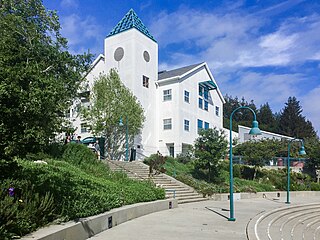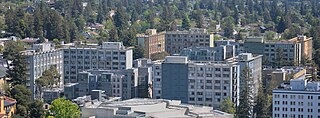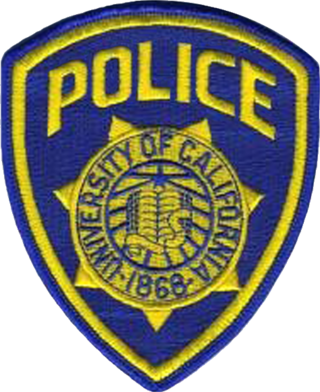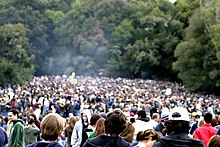
The University of California, Santa Cruz is a public land-grant research university in Santa Cruz, California. It is one of the ten campuses in the University of California system. Located on Monterey Bay, on the edge of the coastal community of Santa Cruz, the main campus lies on 2,001 acres (810 ha) of rolling, forested hills overlooking the Pacific Ocean. As of Fall 2022, its ten residential colleges enroll some 17,500 undergraduate and 2,000 graduate students. Satellite facilities in other Santa Cruz locations include the Coastal Science Campus and the Westside Research Park and the Silicon Valley Center in Santa Clara.

Kresge College is one of the residential colleges that make up the University of California, Santa Cruz. Founded in 1971 and named after Sebastian Kresge, Kresge college is located on the western edge of the UCSC campus. Kresge is the sixth of ten colleges at UCSC, and originally one of the most experimental. The first provost of Kresge, Bob Edgar, had been strongly influenced by his experience in T-groups run by NTL Institute. He asked a T-group facilitator, psychologist Michael Kahn, to help him start the college. When they arrived at UCSC, they taught a course, Creating Kresge College, in which they and the students in it designed the college. Kresge was a participatory democracy, and students had extraordinary power in the early years. The college was run by two committees: Community Affairs and Academic Affairs. Any faculty member, student or staff member who wanted to be on these committees could be on them. Students' votes counted as much as the faculty or staff. These committees determined the budgets and hiring. They were also run by consensus. Distinguished early faculty members included Gregory Bateson, former husband of Margaret Mead and author of Steps to an Ecology of Mind; Phil Slater, author of The Pursuit of Loneliness; John Grinder, co-founder of Neuro-linguistic programming and co-author of The Structure of Magic; and William Everson, one of the Beat poets.

Crown College is one of the residential colleges that makes up the University of California, Santa Cruz, United States.

The first of the ten residential colleges of the University of California, Santa Cruz, established in 1965, Cowell College sits on the edge of a redwood forest with a remarkable view of Monterey Bay. The college is named for Henry Cowell and the Cowell family, who donated the land that UCSC is built upon, previously known as the Cowell Ranch.
A residential college is a division of a university that places academic activity in a community setting of students and faculty, usually at a residence and with shared meals, the college having a degree of autonomy and a federated relationship with the overall university. The term residential college is also used to describe a variety of other patterns, ranging from a dormitory with some academic programming, to continuing education programs for adults lasting a few days. In some parts of the world it simply refers to any organized on-campus housing, an example being University of Malaya.

Adlai E. Stevenson College, known colloquially as Stevenson College, is a residential college at the University of California, Santa Cruz. Currently, the college is host to the Linguistics Department, as well as many humanities faculty.

Merrill College is a residential college at the University of California, Santa Cruz. The theme of the college, and the name of its freshman core course, is "cultural identities and global consciousness."

Oakes College is a residential college at the University of California, Santa Cruz. It is on the southwestern corner of the campus, south of Rachel Carson College and east of the Family Student Housing complex.

Rachel Carson College is a residential college at the University of California, Santa Cruz. Named in honor of conservationist Rachel Carson, it is on the west side of campus, north of Oakes College and southeast of Porter College. The current provost of the college is Professor Sue Carter, also a faculty member of UCSC's Physics Department. The theme of its freshman core course is Environment and Society.

College Nine is a residential college at the University of California, Santa Cruz. The university's first new college in nearly 30 years, College Nine was founded in 2000 although the dorms were not finished until 2002. It is located on the north side of campus, east of Science Hill and west of Crown College. The college theme is International and Global Perspectives. All freshmen students are required to take a core course on this particular theme.

John R. Lewis College, formerly known as College Ten, is one of the ten residential colleges at the University of California, Santa Cruz. It is on the north side of campus, west of College Nine and north of the Cowell Student Health Center. The theme of its freshman core course is Social Justice and Community.

Housing at the University of California, Berkeley, includes student housing facilities run by the office of Residential and Student Service Programs (RSSP). Housing is also offered by off-campus entities such as fraternities and sororities and the Berkeley Student Cooperative (BSC).
The Baskin School of Engineering, known simply as Baskin Engineering, is the school of engineering at the University of California, Santa Cruz. It consists of six departments: Applied Mathematics, Biomolecular Engineering, Computational Media, Computer Science and Engineering, Electrical and Computer Engineering, and Statistics.
History of Consciousness is the name of a department in the Humanities Division of the University of California, Santa Cruz with a 50+ year history of interdisciplinary research and student training in "established and emergent disciplines and fields" in the humanities, arts, sciences, and social sciences based on a diverse array of theoretical approaches. The program has a history of well-known affiliated faculty and of well-known program graduates.
Student housing at the University of California, Irvine, is separated between first-year students, continuing students, graduate students, and faculty. These accommodations serve the traditional purpose of housing residents and serve as a long-term outreach incentive for first-year students and faculty. Student housing also plays a crucial role in developing campus-wide social activities.

The police departments of the University of California system are charged with providing law enforcement to each of the system's campuses.
The UCSC Silicon Valley Initiatives are a series of educational and research activities which together increase the presence of the University of California in Silicon Valley. To that end, UC Santa Cruz has set up a 90,000 square-foot satellite campus called the University of Santa Cruz Silicon Valley Campus (SVC), currently located on Bowers street in Santa Clara, California, where it has been since April 2016 The Initiatives, still in the early stages of their development, have had ambitious hopes attached to them by UCSC, among them the possibility of a home for the University's long-planned graduate school of management and the Bio|Info|Nano R&D Institute. It currently houses professional the SVLink incubator-accelerator program, programs and a distance education site for the UCSC Baskin School of Engineering, the UCSC Silicon Valley Extension, the Office of Industry Alliances and Technology Commercialization leadership, and the University of California's online learning program, UC Scout.

The Coastal Science Campus of the University of California, Santa Cruz consists of five main institutions: UC Santa Cruz's Long Marine Laboratory, UC Santa Cruz's Coastal Biology Building, the NOAA Southwest Fisheries Science Center, the Seymour Marine Discovery Center, and the California Marine Wildlife Veterinary Care and Research Center.

Wilder Ranch State Park is a California State Park on the Pacific Ocean coast north of Santa Cruz, California. The park was formerly a dairy ranch, and many of the ranch buildings have been restored for use as a museum. There are no campgrounds; a day-use parking lot provides access to the museum. Dogs are prohibited on the trails, but many trails allow bikes and/or horses. The long trails and ocean views make the area a favorite of hikers, equestrians and mountain bikers. Public beaches continue to the north in Coast Dairies State Park.

The UC Santa Cruz Banana Slugs are the athletic teams that represent the University of California, Santa Cruz. The Banana Slugs compete in Division III of the NCAA, mostly in the Coast to Coast Athletic Conference (C2C). There are fifteen varsity sports – men's and women's basketball, tennis, soccer, volleyball, swimming and diving, cross country, track & field, and women's golf. UCSC teams have been Division III nationally ranked in tennis, soccer, men's volleyball, and swimming. UCSC maintains a number of successful club sides.



















